engine oil MITSUBISHI GRANDIS 2008 Owner's Manual (in English)
[x] Cancel search | Manufacturer: MITSUBISHI, Model Year: 2008, Model line: GRANDIS, Model: MITSUBISHI GRANDIS 2008Pages: 458, PDF Size: 18.52 MB
Page 2 of 458
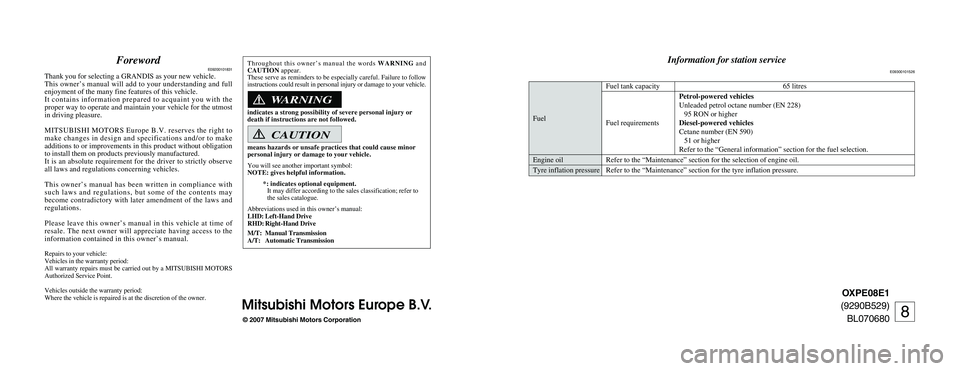
OXPE08E1
(9290B529)
BL070680
© 2007 Mitsubishi Motors Corporation
Mitsubishi Motors Europe B.V.
ForewordE09200101831
Thank you for selecting a GRANDIS as your new vehicle.
This owner’s manual will add to your understanding and full
enjoyment of the many fine features of this vehicle.
It contains information prepared to acquaint you with the
proper way to operate and maintain your vehicle for the utmost
in driving pleasure.
MITSUBISHI MOTORS Europe B.V. reserves the right to
make changes in design and specifications and/or to make
additions to or improvements in this product without obligation
to install them on products previously manufactured.
It is an absolute requirement for the driver to strictly observe
all laws and regulations concerning vehicles.
This owner’s manual has been written in compliance with
such laws and regulations, but some of the contents may
become contradictory with later amendment of the laws and
regulations.
Please leave this owner’s manual in this vehicle at time of
resale. The next owner will appreciate having access to the
information contained in this owner’s manual.
Repairs to your vehicle:
Vehicles in the warranty period:
All warranty repairs must be carried out by a MITSUBISHI MOTORS
Authorized Service Point.
Vehicles outside the warranty period:
Where the vehicle is repaired is at the discretion of the owner.Throughout this owner’s manual the words WARNINGand
CAUTIONappear.
These serve as reminders to be especially careful. Failure to follow
instructions could result in personal injury or damage to your vehicle.
indicates a strong possibility of severe personal injury or
death if instructions are not followed.
means hazards or unsafe practices that could cause minor
personal injury or damage to your vehicle.
You will see another important symbol:
NOTE: gives helpful information.
*: indicates optional equipment.
It may differ according to the sales classification; refer to
the sales catalogue.
Abbreviations used in this owner’s manual:
LHD: Left-Hand Drive
RHD: Right-Hand Drive
M/T: Manual Transmission
A/T: Automatic Transmission
WARNING
CAUTION
Information for station service
E09300101526
Fuel tank capacity 65 litres
Petrol-powered vehicles
Unleaded petrol octane number (EN 228)
Fuel95 RON or higher
Fuel requirementsDiesel-powered vehicles
Cetane number (EN 590)
51 or higher
Refer to the “General information” section for the fuel selection.
Engine oil Refer to the “Maintenance” section for the selection of engine oil.
Tyre inflation pressure Refer to the “Maintenance” section for the tyre inflation pressure.
8
eng270680_XP08_cv 05-07-2007 12:31 Page 2
Page 15 of 458
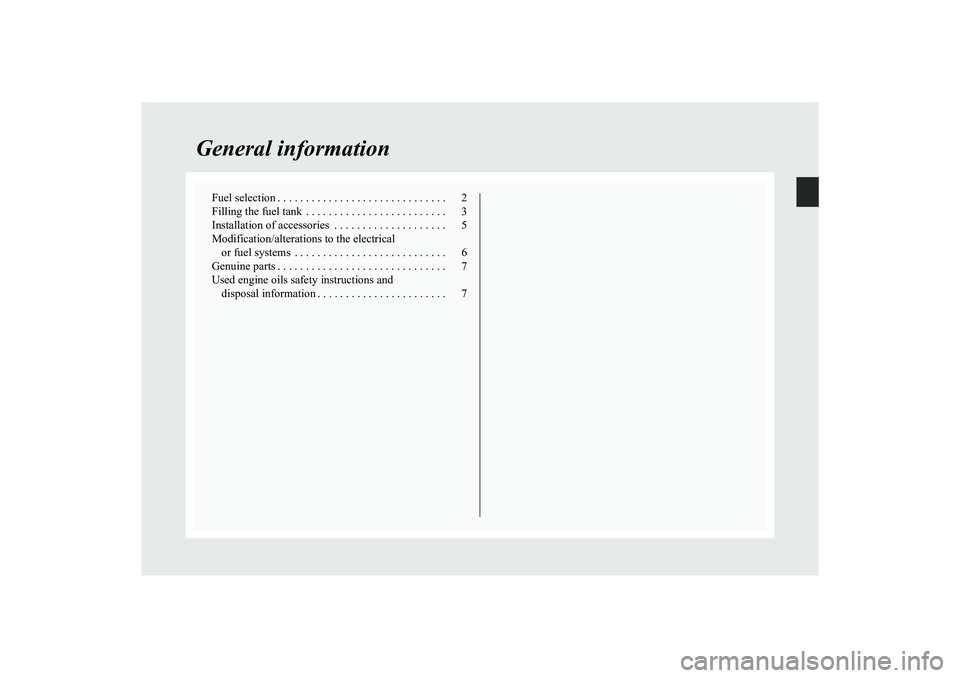
General information
Fuel selection . . . . . . . . . . . . . . . . . . . . . . . . . . . . . . 2
Filling the fuel tank . . . . . . . . . . . . . . . . . . . . . . . . . 3
Installation of accessories . . . . . . . . . . . . . . . . . . . . 5
Modification/alterations to the electrical
or fuel systems . . . . . . . . . . . . . . . . . . . . . . . . . . . 6
Genuine parts . . . . . . . . . . . . . . . . . . . . . . . . . . . . . . 7
Used engine oils safety instructions and
disposal information . . . . . . . . . . . . . . . . . . . . . . . 7
BK-XP08E1ENUK.en-uk.book Page 1 Monday, August 13, 2007 2:20 PM
Page 21 of 458
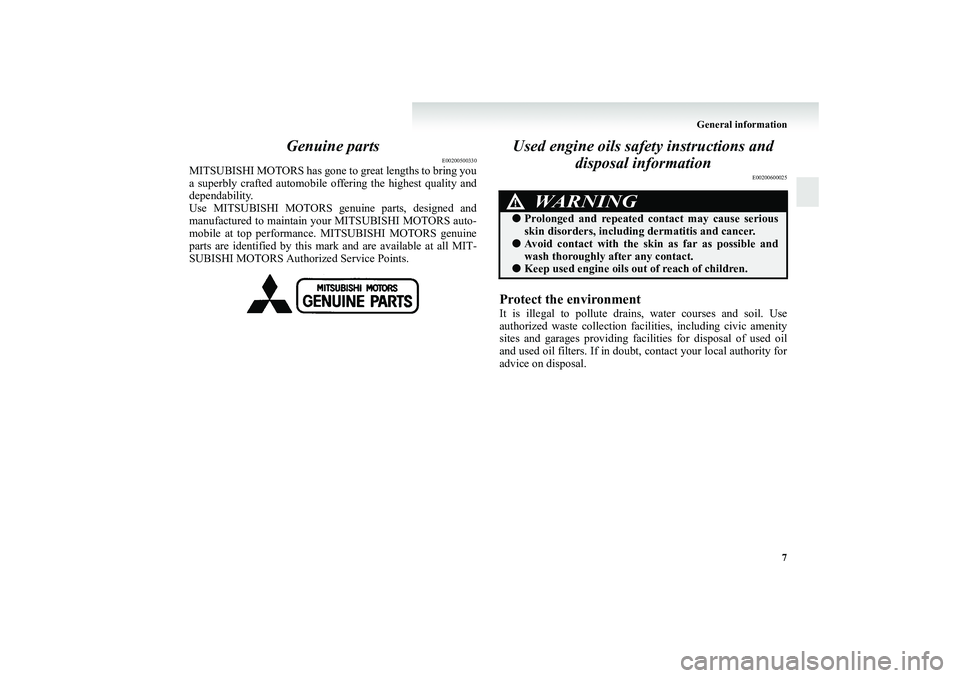
General information
7
Genuine parts
E00200500330
MITSUBISHI MOTORS has gone to great lengths to bring you
a superbly crafted automobile offering the highest quality and
dependability.
Use MITSUBISHI MOTORS genuine parts, designed and
manufactured to maintain your MITSUBISHI MOTORS auto-
mobile at top performance. MITSUBISHI MOTORS genuine
parts are identified by this mark and are available at all MIT-
SUBISHI MOTORS Authorized Service Points.
Used engine oils safety instructions and
disposal information
E00200600025
Protect the environmentIt is illegal to pollute drains, water courses and soil. Use
authorized waste collection facilities, including civic amenity
sites and garages providing facilities for disposal of used oil
and used oil filters. If in doubt, contact your local authority for
advice on disposal.
WARNING
!●Prolonged and repeated contact may cause serious
skin disorders, including dermatitis and cancer.●Avoid contact with the skin as far as possible and
wash thoroughly after any contact.●Keep used engine oils out of reach of children.
BK-XP08E1ENUK.en-uk.book Page 7 Monday, August 13, 2007 2:20 PM
Page 134 of 458
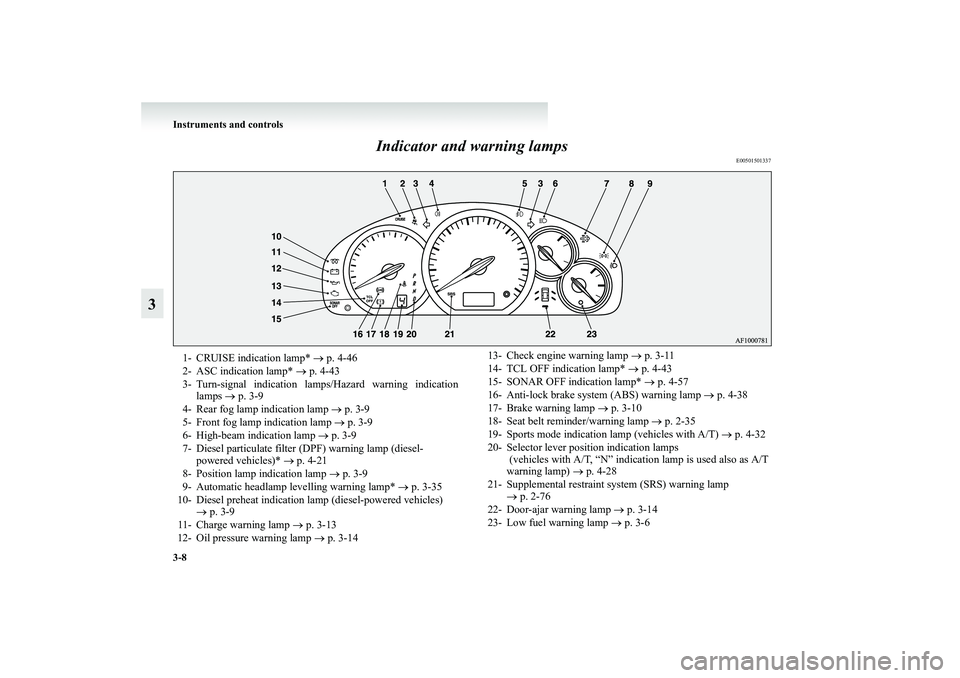
3-8 Instruments and controls
3Indicator and warning lamps
E00501501337
1- CRUISE indication lamp* → p. 4-46
2- ASC indication lamp* → p. 4-43
3- Turn-signal indication lamps/Hazard warning indication
lamps → p. 3-9
4- Rear fog lamp indication lamp → p. 3-9
5- Front fog lamp indication lamp → p. 3-9
6- High-beam indication lamp → p. 3-9
7- Diesel particulate filter (DPF) warning lamp (diesel-
powered vehicles)* → p. 4-21
8- Position lamp indication lamp → p. 3-9
9- Automatic headlamp levelling warning lamp* → p. 3-35
10- Diesel preheat indication lamp (diesel-powered vehicles)
→ p. 3-9
11- Charge warning lamp → p. 3-13
12- Oil pressure warning lamp → p. 3-1413- Check engine warning lamp → p. 3-11
14- TCL OFF indication lamp* → p. 4-43
15- SONAR OFF indication lamp* → p. 4-57
16- Anti-lock brake system (ABS) warning lamp → p. 4-38
17- Brake warning lamp → p. 3-10
18- Seat belt reminder/warning lamp → p. 2-35
19- Sports mode indication lamp (vehicles with A/T) → p. 4-32
20- Selector lever position indication lamps
(vehicles with A/T, “N” indication lamp is used also as A/T
warning lamp) → p. 4-28
21- Supplemental restraint system (SRS) warning lamp
→ p. 2-76
22- Door-ajar warning lamp → p. 3-14
23- Low fuel warning lamp → p. 3-6
BK-XP08E1ENUK.en-uk.book Page 8 Monday, August 13, 2007 2:20 PM
Page 140 of 458
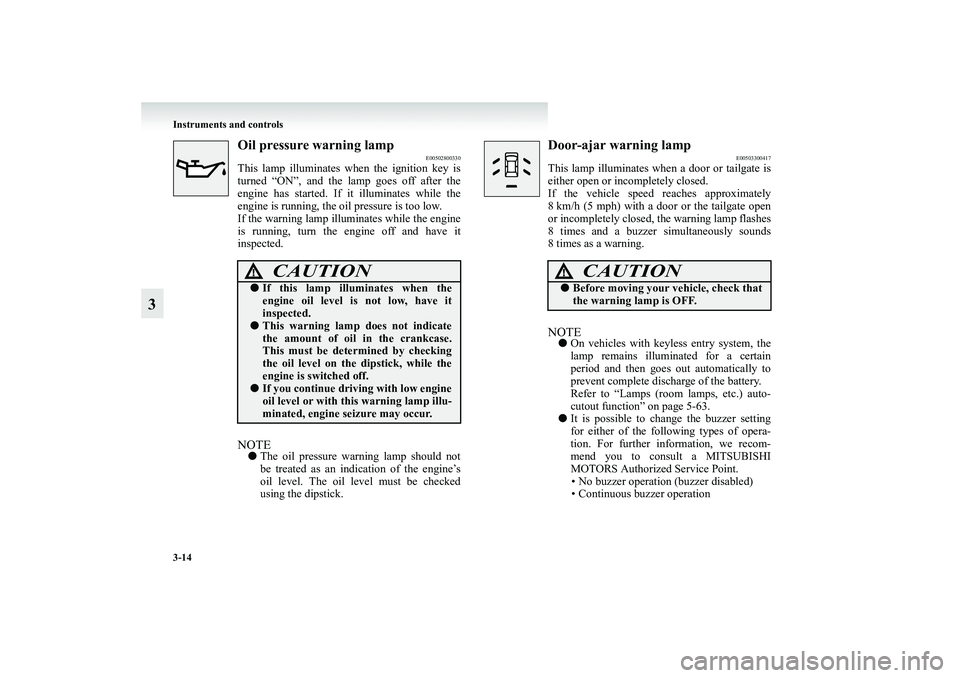
3-14 Instruments and controls
3
Oil pressure warning lamp
E00502800330
This lamp illuminates when the ignition key is
turned “ON”, and the lamp goes off after the
engine has started. If it illuminates while the
engine is running, the oil pressure is too low.
If the warning lamp illuminates while the engine
is running, turn the engine off and have it
inspected.NOTE●The oil pressure warning lamp should not
be treated as an indication of the engine’s
oil level. The oil level must be checked
using the dipstick.
Door-ajar warning lamp
E00503300417
This lamp illuminates when a door or tailgate is
either open or incompletely closed.
If the vehicle speed reaches approximately
8 km/h (5 mph) with a door or the tailgate open
or incompletely closed, the warning lamp flashes
8 times and a buzzer simultaneously sounds
8 times as a warning.NOTE●On vehicles with keyless entry system, the
lamp remains illuminated for a certain
period and then goes out automatically to
prevent complete discharge of the battery.
Refer to “Lamps (room lamps, etc.) auto-
cutout function” on page 5-63.
●It is possible to change the buzzer setting
for either of the following types of opera-
tion. For further information, we recom-
mend you to consult a MITSUBISHI
MOTORS Authorized Service Point.
• No buzzer operation (buzzer disabled)
• Continuous buzzer operation
CAUTION
!●If this lamp illuminates when the
engine oil level is not low, have it
inspected.●This warning lamp does not indicate
the amount of oil in the crankcase.
This must be determined by checking
the oil level on the dipstick, while the
engine is switched off.●If you continue driving with low engine
oil level or with this warning lamp illu-
minated, engine seizure may occur.
CAUTION
!●Before moving your vehicle, check that
the warning lamp is OFF.
BK-XP08E1ENUK.en-uk.book Page 14 Monday, August 13, 2007 2:20 PM
Page 193 of 458

Starting and driving
4-21
4
NOTE●If the engine is cold, the diesel preheat indication lamp is
on for a longer time.
●When the engine has not been started within about 5 sec-
onds after the diesel preheat indication lamp went out,
return the ignition key to the “LOCK” position. Then, turn
the key to the “ON” position to preheat the engine again.
●When the engine is warm, the diesel preheat indication
lamp does not come on even if the ignition key is placed
in the “ON” position.
Start the engine by turning the ignition key right to the
“START” position.
7. Turn the ignition key to the “START” position without
depressing the accelerator pedal, and release it when the
engine starts.NOTE●A ticking noise may be heard after starting the engine.
This is not an abnormal condition. The noise will disap-
pear after a short time of engine running.
If the ticking noise continues after the engine is warmed
up, we recommend you to have your vehicle checked.
Diesel particulate filter (DPF)
*
E00619800069
The diesel particulate filter (DPF) is a device that captures
most of the particulate matter (PM) in the exhaust emissions of
the diesel engine. The DPF automatically burns away trapped
PM during vehicle operation. Under certain driving conditions,
however, the DPF is not able to burn away all of the trapped
PM and, as a result, an excessive amount of PM accumulates
inside.NOTE●To minimize the likelihood of excessive accumulation of
PM, try to avoid driving for long periods at low speeds
and repeatedly driving short distances.
WARNING
!●The DPF reaches very high temperatures. Do not
park your vehicle in areas where combustible mate-
rials such as dry grass or leaves can come in contact
with the hot exhaust system since fire could occur.
CAUTION
!●Do not use any type of fuel or engine oil that is not
specified for your vehicle. Also, do not use any mois-
ture-removing agent or other fuel additive. Such
substances could have a detrimental effect on the
DPF.
Refer to “Fuel selection” on page 2 and “Engine oil”
on page 8-7.
BK-XP08E1ENUK.en-uk.book Page 21 Monday, August 13, 2007 2:20 PM
Page 208 of 458
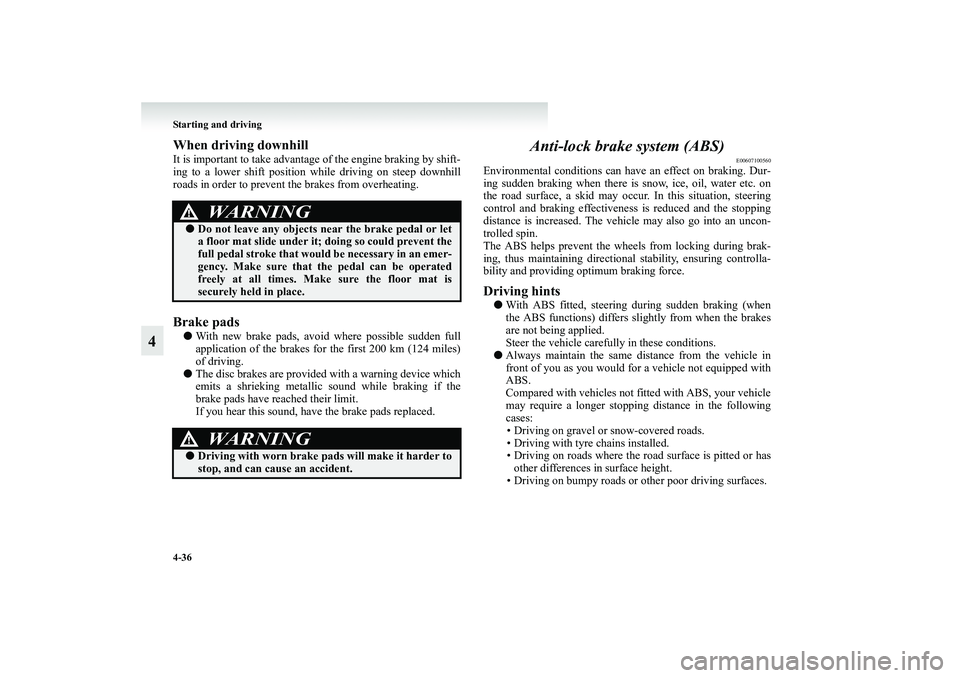
4-36 Starting and driving
4
When driving downhillIt is important to take advantage of the engine braking by shift-
ing to a lower shift position while driving on steep downhill
roads in order to prevent the brakes from overheating.Brake pads●With new brake pads, avoid where possible sudden full
application of the brakes for the first 200 km (124 miles)
of driving.
●The disc brakes are provided with a warning device which
emits a shrieking metallic sound while braking if the
brake pads have reached their limit.
If you hear this sound, have the brake pads replaced.
Anti-lock brake system (ABS)
E00607100560
Environmental conditions can have an effect on braking. Dur-
ing sudden braking when there is snow, ice, oil, water etc. on
the road surface, a skid may occur. In this situation, steering
control and braking effectiveness is reduced and the stopping
distance is increased. The vehicle may also go into an uncon-
trolled spin.
The ABS helps prevent the wheels from locking during brak-
ing, thus maintaining directional stability, ensuring controlla-
bility and providing optimum braking force.Driving hints●With ABS fitted, steering during sudden braking (when
the ABS functions) differs slightly from when the brakes
are not being applied.
Steer the vehicle carefully in these conditions.
●Always maintain the same distance from the vehicle in
front of you as you would for a vehicle not equipped with
ABS.
Compared with vehicles not fitted with ABS, your vehicle
may require a longer stopping distance in the following
cases:
• Driving on gravel or snow-covered roads.
• Driving with tyre chains installed.
• Driving on roads where the road surface is pitted or has
other differences in surface height.
• Driving on bumpy roads or other poor driving surfaces.
WARNING
!●Do not leave any objects near the brake pedal or let
a floor mat slide under it; doing so could prevent the
full pedal stroke that would be necessary in an emer-
gency. Make sure that the pedal can be operated
freely at all times. Make sure the floor mat is
securely held in place.
WARNING
!●Driving with worn brake pads will make it harder to
stop, and can cause an accident.
BK-XP08E1ENUK.en-uk.book Page 36 Monday, August 13, 2007 2:20 PM
Page 321 of 458
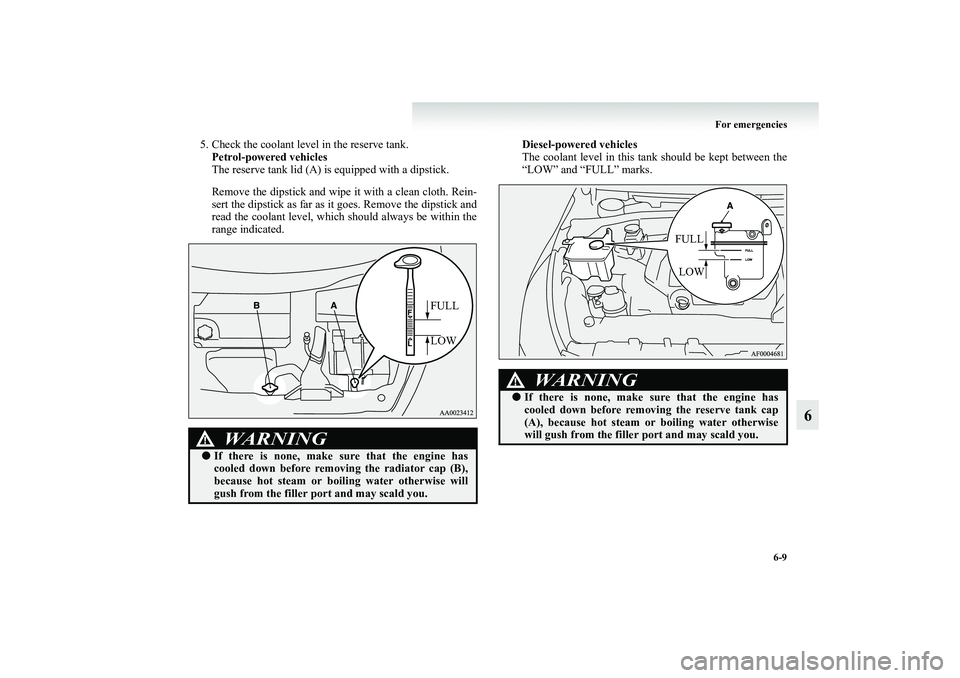
For emergencies
6-9
6
5. Check the coolant level in the reserve tank.
Petrol-powered vehicles
The reserve tank lid (A) is equipped with a dipstick.
Remove the dipstick and wipe it with a clean cloth. Rein-
sert the dipstick as far as it goes. Remove the dipstick and
read the coolant level, which should always be within the
range indicated.Diesel-powered vehicles
The coolant level in this tank should be kept between the
“LOW” and “FULL” marks.
WARNING
!●If there is none, make sure that the engine has
cooled down before removing the radiator cap (B),
because hot steam or boiling water otherwise will
gush from the filler port and may scald you.
FULL
LOW
WARNING
!●If there is none, make sure that the engine has
cooled down before removing the reserve tank cap
(A), because hot steam or boiling water otherwise
will gush from the filler port and may scald you.
FULL
LOW
BK-XP08E1ENUK.en-uk.book Page 9 Monday, August 13, 2007 2:20 PM
Page 340 of 458
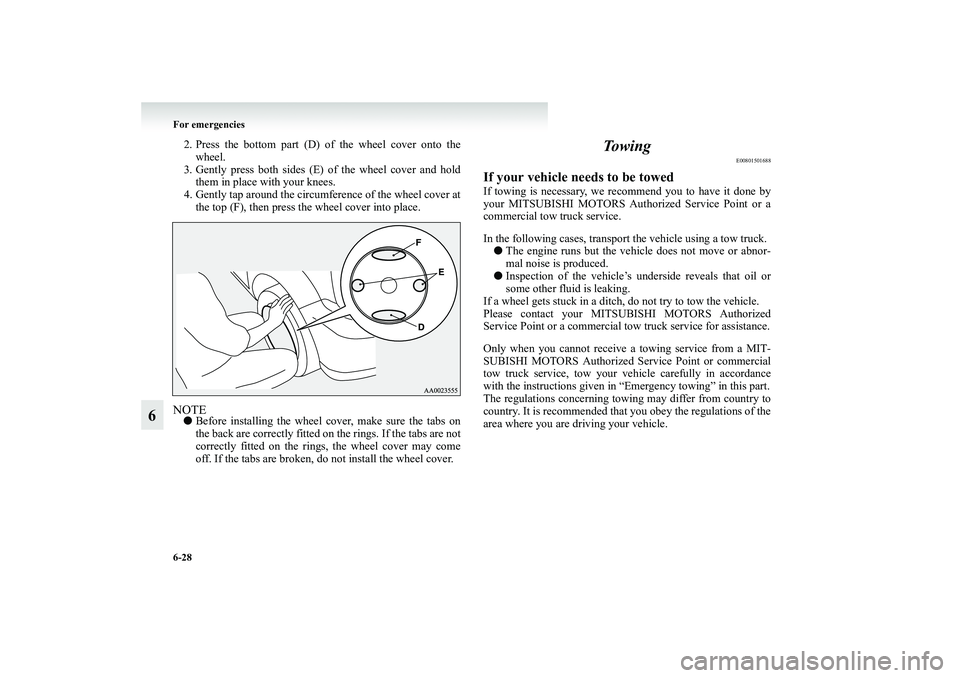
6-28 For emergencies
6
2. Press the bottom part (D) of the wheel cover onto the
wheel.
3. Gently press both sides (E) of the wheel cover and hold
them in place with your knees.
4. Gently tap around the circumference of the wheel cover at
the top (F), then press the wheel cover into place.NOTE●Before installing the wheel cover, make sure the tabs on
the back are correctly fitted on the rings. If the tabs are not
correctly fitted on the rings, the wheel cover may come
off. If the tabs are broken, do not install the wheel cover.
To w i n g
E00801501688
If your vehicle needs to be towedIf towing is necessary, we recommend you to have it done by
your MITSUBISHI MOTORS Authorized Service Point or a
commercial tow truck service.
In the following cases, transport the vehicle using a tow truck.
●The engine runs but the vehicle does not move or abnor-
mal noise is produced.
●Inspection of the vehicle’s underside reveals that oil or
some other fluid is leaking.
If a wheel gets stuck in a ditch, do not try to tow the vehicle.
Please contact your MITSUBISHI MOTORS Authorized
Service Point or a commercial tow truck service for assistance.
Only when you cannot receive a towing service from a MIT-
SUBISHI MOTORS Authorized Service Point or commercial
tow truck service, tow your vehicle carefully in accordance
with the instructions given in “Emergency towing” in this part.
The regulations concerning towing may differ from country to
country. It is recommended that you obey the regulations of the
area where you are driving your vehicle.
BK-XP08E1ENUK.en-uk.book Page 28 Monday, August 13, 2007 2:20 PM
Page 355 of 458
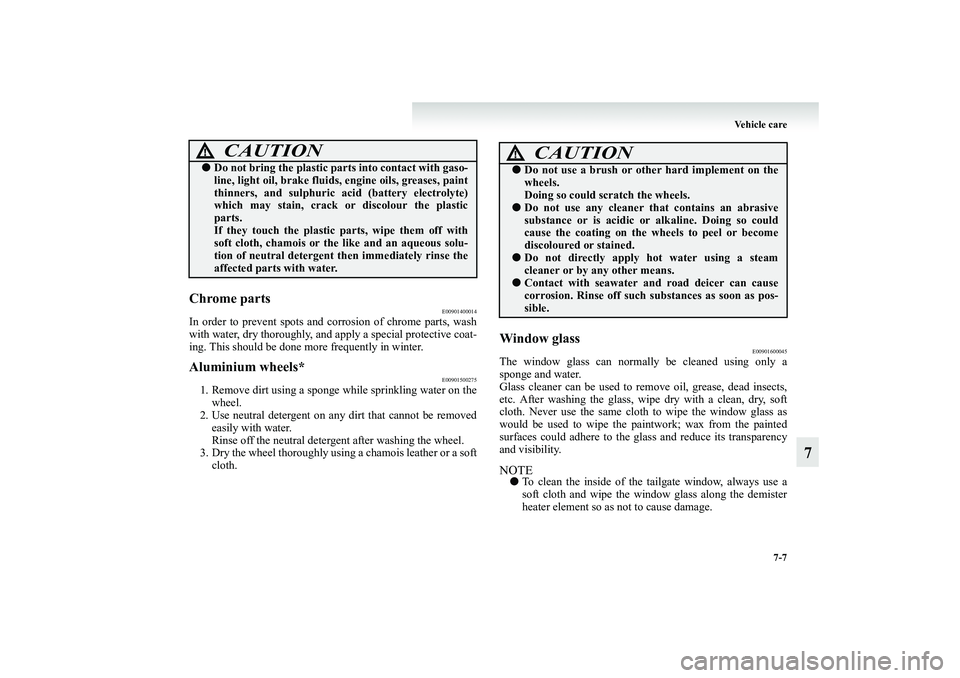
Vehicle care
7-7
7
Chrome parts
E00901400014
In order to prevent spots and corrosion of chrome parts, wash
with water, dry thoroughly, and apply a special protective coat-
ing. This should be done more frequently in winter.Aluminium wheels*
E00901500275
1. Remove dirt using a sponge while sprinkling water on the
wheel.
2. Use neutral detergent on any dirt that cannot be removed
easily with water.
Rinse off the neutral detergent after washing the wheel.
3. Dry the wheel thoroughly using a chamois leather or a soft
cloth.
Window glass
E00901600045
The window glass can normally be cleaned using only a
sponge and water.
Glass cleaner can be used to remove oil, grease, dead insects,
etc. After washing the glass, wipe dry with a clean, dry, soft
cloth. Never use the same cloth to wipe the window glass as
would be used to wipe the paintwork; wax from the painted
surfaces could adhere to the glass and reduce its transparency
and visibility.NOTE●To clean the inside of the tailgate window, always use a
soft cloth and wipe the window glass along the demister
heater element so as not to cause damage.
●Do not bring the plastic parts into contact with gaso-
line, light oil, brake fluids, engine oils, greases, paint
thinners, and sulphuric acid (battery electrolyte)
which may stain, crack or discolour the plastic
parts.
If they touch the plastic parts, wipe them off with
soft cloth, chamois or the like and an aqueous solu-
tion of neutral detergent then immediately rinse the
affected parts with water.
CAUTION
!
CAUTION
!●Do not use a brush or other hard implement on the
wheels.
Doing so could scratch the wheels.●Do not use any cleaner that contains an abrasive
substance or is acidic or alkaline. Doing so could
cause the coating on the wheels to peel or become
discoloured or stained.●Do not directly apply hot water using a steam
cleaner or by any other means.●Contact with seawater and road deicer can cause
corrosion. Rinse off such substances as soon as pos-
sible.
BK-XP08E1ENUK.en-uk.book Page 7 Monday, August 13, 2007 2:20 PM